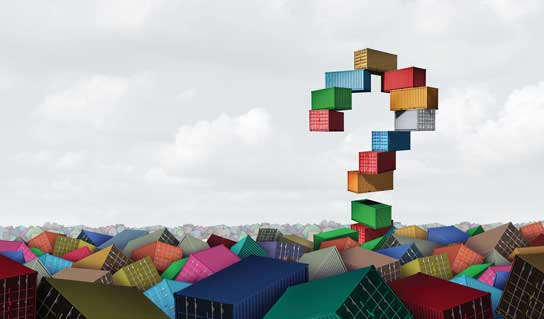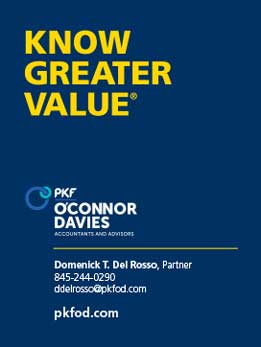PKF O’CONNOR DAVIES | BY LAWRENCE BAYE, CMC, CISA
SUPPLY CHAIN UNCERTAINTY IN 2023
Prior to March 2020, most organizations minimized their investment in products, supplies, and other types of materials and avoided the risk of obsolescence by maintaining relatively lean stock levels, choosing to replenish items on a just-in-time basis. This approach relied upon the ability to accurately forecast demand based on understanding customer purchasing habits and the analysis of sales history and patterns. Manufacturers and distributors recognized that stockouts occasionally occurred and buyers/consumers tolerated periodic backorders.
To minimize costs, most companies relied on foreign-owned or contract factories offering low labor rates, less restrictive environmental and work rules and, where feasible, positioned production near raw material sources. Under this model, organizations accepted the risk of doing business globally and recognized the importance of proactively monitoring distant resources. While some production that involved highly technical and/or automated processes was performed domestically, most often it was limited to assembly, packaging, and distribution.
Despite periodic discussions about re-shoring manufacturing to the Americas to shorten transportation time and reduce dependence on overseas suppliers, few meaningful tax and economic incentives were created in recent years to actually spur more local capital investment.

The Pandemic Exposed Serious Supply Chain Vulnerabilities
With COVID infections surging in 2020, federal and state governments, as well as health care institutions, realized that there were limited supplies of personal protective equipment (e.g., masks, sanitizers) and critical medical devices (e.g., ventilators) due to an uptick in global demand, the shutdown of factories in Asia where these items were made, and a shortage of components/raw materials (e.g., cans/bottles for sanitizers, mask clips). In addition, some of the older equipment in the federal stockpile was found to be unusable.
Every organization was forced to adjust their operations on-the-fly. COVID outbreaks in congested workspaces (e.g., meat processors) reduced the labor force; managers depleted whatever stock they held in-house; buyers scrambled to purchase from vendors; and, in many sectors, employees required new or additional technology to work from home. Since few had lived through a pandemic, organizations were ill prepared to address these new challenges. They assumed supply chain resiliency and never considered the impact of a disruption when they created their business continuity and crisis management plans, identified alternate suppliers or developed the capability to leverage data analytics to chart a course forward. While quickly building new production or distribution capacity or expanding existing facilities looked attractive, such projects require significant lead time and funding. They only happen if there is certainty regarding long-term demand that justifies the investment.
Complicating the situation was a change in customer/consumer behavior. Disposable income that would normally be spent on travel, entertainment, and services was directed toward home purchases, expansion or space reconfiguration to accommodate leisure and work requirements and helping drive up the cost of building materials. The convenience of online ordering, home delivery (e.g., FedEx) and returns (e.g., Staples drop-off of UPS packages) accelerated the shift away from in-person shopping to online platforms that offered 24×365 access with a broader selection of parts, styles, and sizes and acceptance of electronic payments. At the same time, chip shortages impacted the sale of computers, automobiles, and equipment contributed to soaring energy prices.

Current State and Prospects for 2023
Supply scarcity seems to be spreading (e.g., beef, poultry, paper goods, appliances, metal, spare parts) and retailers, other merchants, and vendors have responded by limiting quantities of certain items, reducing their hours of operation or, in some cases, not taking orders uncertain when an item will be in-stock. A shortage of truckers has created a buildup of idle chassis, pallets, and containers. At the same time, the number of unfilled jobs has grown significantly due to early retirements, employer vaccine mandates, and employees who have quit the workforce. The spread of COVID infections among workers has exacerbated the labor shortage.
Supply chain disruption does not impact each industry in the same way. While inventory-driven businesses like manufacturers, distributors, retailers, and online merchants need raw materials, components for assembly and packaging and spare parts to keep equipment working, logistics and transportation companies operating warehouses or providing shipping services, require more storage capacity strategically situated near their customers. Real estate and construction companies need building materials and equipment for capital projects, renovation and maintenance. Organizations that provide business and professional services and those in the not-for-profit sector require office and maintenance supplies, furniture, and computers.
Emerging Supply Chain Uncertainties In 2023
While Wall Street, economists, financial executives, and government officials hold differing views on the likelihood of a recession and if it occurs, its duration and severity, here are some indicators and trends that you should closely watch and assess how and if they might impact your organization’s supply chain in 2023:
- China has relaxed its “zero COVID” policy so the country is experiencing widespread infection. Significant worker illness might lead to reductions in production and possibly the reimposition of restrictive policies that result in a similar outcome. If this happens, have you sufficiently diversified your suppliers so alternate raw material and finished goods manufacturers are ready-to-go with ample capacity to make up the shortfall? Further, if you sell goods in China, might there be a reduction in demand?
- Many retailers have accumulated more inventory than they need to satisfy current demand. This buildup is a result of delayed factory shipments in the Fall of 2022, the expectation that higher levels of demand would continue and a disappointing holiday season where sales were below target. If the retailers significantly discount your goods in order to sell them, unload them through jobbers or discount chains, decide to hold them for a future season or impose restocking fees to discourage returns, will that adversely impact your brand image, and will other customers expect price concessions if they believe that they have to drop their selling price to remain competitive?
- As product prices have increased, consumers have changed their buying habits and are prioritizing spending on food, fuel, shelter, and other essentials instead of apparel, appliances, and other items that they deem to be less essential now. The recent layoffs of higher earners in the technology, media, consumer products, and financial services sectors may lead these individuals to defer big purchases and make those employed more cautious with their own money. For organizations that sell products that have become slow-movers, how would your organization react to a customer’s request to take back unsold/excess inventory and have you adjusted your operational and financial projections to reflect the possibility of lower reorders?
- Certain retailers have closed some of their stores and others in poor financial health may do the same. Often these measures precede a change in ownership, restructuring, or bankruptcy filing. Are any of these retailers your customers, might you become a creditor, and is your exposure significant enough that it could put your own business at risk? If you are instead a customer of these retailers, have you found other sources for the items you may want to buy?
- While businesses were able to pass-thru supply and labor cost increases by raising prices, consumers have started to push back by purchasing lower cost private brand items or buying lower quantities. If you were forced to drop product prices in order to preserve the customer relationship and market share, have you considered what options you have to cut the cost of raw materials, labor, packaging, and logistics? Is it feasible to shrink package size and content, transport goods by ship not air, design less expensive models of the same product, substitute less costly components, eliminate duplicate brands that target the same segment or identify other ways to save?
- In different parts of the country, there are ongoing shortages of baby formula, prescription and over-the-counter medicines, eggs, construction material, and other products. How might these limitations effect your business, including what you sell (e.g. eggs are critical in baking) or what you need to operate effectively (e.g. hospitals need a reliable supply of drugs to treat patients with chronic conditions)? Have you checked whether any of your supply requirements maybe in short supply?
Many of the challenges noted are by-products of macroeconomic and geopolitical conditions such as climate change, war, inflation, and foreign policies over which owners, executives, managers and Boards have little control. You can, however, build a resilient supply chain, develop robust forecasting models and analytical tools and ensure that you have real time visibility so supply chain issues can be identified early and promptly addressed.




